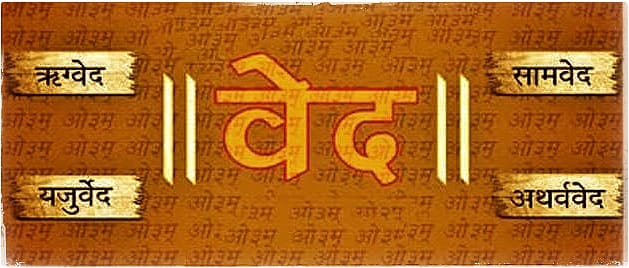वेद ईश्वरीय या मानवनिर्मित
वेद पौरुषेय (मानवनिर्मित) है या अपौरुषेय (ईश्वरप्रणीत)। वेद का स्वरूप क्या है? इस महत्त्वपूर्ण प्रश्न का स्पष्ट उत्तर ऋग्वेद में इस प्रकार है-'वेद' परमेश्वर के मुख से निकला हुआ 'परावाक' है, वह 'अनादि' एवं 'नित्य' कहा गया है। वह अपौरुषेय ही है।
इस विषय में मनुस्मृति कहती है कि अति प्राचीन काल के ऋषियों ने उत्कट तपस्या द्वारा अपने तप:पूत हृदय में 'परावाक' वेदवाड्मय का साक्षात्कार किया था, अत: वे मन्त्रद्रष्टा ऋषि कहलाये-'ऋषयो मन्त्रद्रष्टार:।'
बृहदारण्यकोपनिषद में उल्लेख है- 'अस्य महतो भूतस्य निश्वसितमेतद्यदृग्वेदो यजुर्वेद: सामवेदोऽथर्वाग्डिरस।' अर्थात उन महान परमेश्वर के द्वारा (सृष्टि- प्राकट्य होने के साथ ही)–ऋग्वेद, यजुर्वेद, सामवेद और अथर्ववेद नि:श्वास की तरह सहज ही बाहर प्रकट हुए। तात्पर्य यह है कि परमात्मा का नि:श्वास ही वेद है। इसके विषय में वेद के महापण्डित सायणाचार्य अपने वेद भाष्य में लिखते हैं-
यस्य नि:श्वसितं वेदा यो वेदेभ्योऽखिलं जगत्।
निर्ममे तमहं वन्दे विद्यातीर्थं महेश्वरम्॥
सारांश यह कि वेद परमेश्वर का नि:श्वास है, अत: परमेश्वर द्वारा ही निर्मित है। वेद से ही समस्त जगत का निर्माण हुआ है। इसीलिये वेद को अपौरुषेय कहा गया है। सायणाचार्य के इन विचारों का समर्थन पाश्चात्य वेद विद्वान प्रो0 विल्सन, प्रो0 मैक्समूलर आदि ने अपने पुस्तकों में किया है।
प्रो0 विल्सन लिखते हैं कि 'सायणाचार्य का वेद विषयक ज्ञान अति विशाल और अति गहन है, जिसकी समकक्षता का दावा कोई भी यूरोपीय विद्वान नहीं कर सकता।'
प्रो0 मैक्समूलर लिखते हैं कि 'यदि मुझे सायणाचार्यरहित बृहद वेदभाष्य पढ़ने को नहीं मिलता तो मैं वेदार्थों के दुर्भेद्य क़िला में प्रवेश ही नहीं पा सका होता।' इसी प्रकार पाश्चात्त्य वेद विद्वान वेबर, बेनफी, राथ, ग्राम्सन, लुडविग, ग्रिफिथ, कीथ तथा विंटरनित्ज आदि ने सायणाचार्य के वेद विचारों का ही प्रतिपादन किया है।
निरूक्तकार 'यास्काचार्य' भाषाशास्त्र के आद्यपण्डित माने गये हैं। उन्होंने अपने महाग्रन्थ वेदभाष्य में स्पष्ट लिखा है कि 'वेद अनादि, नित्य एवं अपौरुषेय (ईश्वरप्रणीत)ही है।' उनका कहना है कि 'वेद का अर्थ समझे बिना केवल वेदपाठ करना पशु की तरह पीठ पर बोझा ढोना ही है; क्योंकि अर्थज्ञानरहित शब्द (मन्त्र) प्रकाश (ज्ञान) नहीं दे सकता। जिसे वेद-मन्त्रों का अर्थ-ज्ञान हुआ है, उसी का लौकिक एवं पारलौकिक कल्याण होता है।' ऐसे वेदार्थ ज्ञान का मार्ग दर्शक निरूक्त है।
जर्मनी के वेद विद्वान प्रो0 मैक्समूलर कहते हैं कि 'विश्व का प्राचीनतम वाड्मय वेद ही है, जो दैविक एवं आध्यात्मिक विचारों को काव्यमय भाषा में अद्भुत रीति से प्रकट करने वाला कल्याणप्रदायक है। वेद परावाक है।' नि:संदेह परमेश्वर ने ही परावाक (वेदवाणी) का निर्माण किया है- ऐसा महाभारत में स्पष्ट कहा गया है-'अनादिनिधना विद्या वागुत्सृष्टा स्वयम्भुवा॥' अर्थात जिसमें से सर्वजगत उत्पन्न हुआ, ऐसी अनादि वेद-विद्यारूप दिव्य वाणी का निर्माण जगन्निर्माता ने सर्वप्रथम किया।
ऋषि वेद मन्त्रों के कर्ता नहीं अपितु द्रष्टा ही थे- 'ऋषयो मन्त्रद्रष्टार:।' निरूक्तकार ने भी कहा है- वेद मन्त्रों के साक्षात्कार होने पर साक्षात्कारी को ऋषि कहा जाता है- 'ऋषिर्दर्शनात्।' इससे स्पष्ट होता है कि वेद का कर्तृत्व अन्य किसी के पास नहीं होने से वेद ईश्वरप्रणीत ही है, अपौरुषेय ही है।
भारतीय दर्शन शास्त्र के मतानुसार शब्द को नित्य कहा गया है। वेद ने शब्द को नित्य माना है, अत: वेद अपौरुषेय है यह निश्चित होता है। निरूक्तकार कहते हैं कि 'नियतानुपूर्व्या नियतवाचो युक्तय:।' अर्थात शब्द नित्य है, उसका अनुक्रम नित्य है और उसकी उच्चारण-पद्धति भी नित्य है, इसीलिये वेद के अर्थ नित्य हैं। ऐसी वेदवाणी का निर्माण स्वयं परमेश्वर ने ही किया है।
शब्द की चार अवस्थाएँ मानी गयी हैं-
यजुर्वेद का आवरण पृष्ठ
1.परा,
2.पश्यन्ती,
3.मध्यमा और
4.वैखरी। ऋग्वेद- में इनके विषय में इस प्रकार कहा गया है-
चत्वारि वाक् परिमिता पदानि तानि विदुर्ब्राह्मणा ये मनीषिण:।
गुहा त्रीणि निहिता नेग्डयन्ति तुरीयं वाचो मनुष्य वदन्ति॥
अर्थात वाणी के चार रूप होने से उन्हें ब्रह्मज्ञानी ही जानते हैं। वाणी के तीन रूप गुप्त हैं, चौथा रूप शब्दमय वेद के रूप में लोगों में प्रचारित होता है।
सूक्ष्मातिसूक्ष्म-ज्ञान को परावाक कहते हैं। उसे ही वेद कहा गया है। इस वेदवाणी का साक्षात्कार महा तपस्वी ऋषियों को होने से इसे 'पश्यन्तीवाक' कहते हैं। ज्ञानस्वरूप वेद का आविष्कार शब्दमय है। इस वाणी का स्थूल स्वरूप ही 'मध्यमावाक' है। वेदवाणी के ये तीनों स्वरूप अत्यन्त रहस्यमय हैं। चौथी 'वैखरीवाक' ही सामान्य लोगों की बोलचाल की है। शतपथ ब्राह्मण तथा माण्डूक्योपनिषद में कहा गया है कि वेद मन्त्र के प्रत्येक पद में, शब्द के प्रत्येक अक्षर में एक प्रकार का अद्भुत सामर्थ्य भरा हुआ है। इस प्रकार की वेद वाणी स्वयं परमेश्वर द्वारा ही निर्मित है, यह नि:शंक है।
शिव पुराण में आया है कि ॐ के 'अ' कार, 'उ' कार, 'म' कार और सूक्ष्मनाद; इनमें से
1.ऋग्वेद,
2.यजुर्वेद,
3.सामवेद तथा
4.अथर्ववेद
नि:सृत हुए। समस्त वाड्मय ओंकार (ॐ)- से ही निर्मित हुआ। 'ओंकारं बिंदुसंयुक्तम्' तो ईश्वररूप ही है।
श्रीमद् भगवद्गीता में भी ऐसा ही उल्लेख है- मयि सर्वमिदं प्रोतं सूत्रे मणिगणा इव॥
श्रीमद्भागवत में तो स्पष्ट कहा गया है- वेदप्रणिहितो धर्मो ह्यधर्मस्तद्विपर्यय:। वेदो नारायण: साक्षात् स्वयम्भूरिति शुश्रुम॥अर्थात वेद भगवान ने जिन कार्यों को करने की आज्ञा दी है वह धर्म है और उससे विपरीत करना अधर्म है। वेद नारायण रूप में स्वयं प्रकट हुआ है, ऐसा श्रुति में कहा गया है।
श्रीमद्भागवत में ऐसा भी वर्णित है- विप्रा गावश्च वेदाश्च तप: सत्यं दम: शम:। श्रद्धा दया तितिक्षा च क्रतवश्च हरेस्तनू:॥ अर्थात वेदज्ञ (सदाचारी भी) ब्राह्मण, दुधारू गाय, वेद, तप, सत्य, दम, शम, श्रद्धा, दया, सहनशीलता और यज्ञ- ये श्रीहरि (परमेश्वर) के स्वरूप हैं।
मनुस्मृति वेद को धर्म का मूल बताते हुए कहती है- वेदोऽखिलो धर्ममूलं स्मृतिशीले च तद्विदाम्। आचारश्चैव साधूनामात्मनस्तुष्टिरेव च ॥अर्थात समग्र वेद एवं वेदज्ञ मनु, पराशर, याज्ञवल्क्य आदि- की स्मृति, शील, आचार, साधु (धार्मिक)- के आत्मा का संतोष-ये सभी धर्मों के मूल हैं।
याज्ञवल्क्यस्मृति में भी कहा गया है- श्रुति: स्मृति: सदाचार: स्वस्य च प्रियमात्मन:। स्म्यक्संकल्पज: कामो धर्ममूलमिदं स्मृतम्॥अर्थात श्रुति, स्मृति, सत्पुरुषों का आचार, अपने आत्मा की प्रीति और उत्तम संकल्प से हुआ (धर्माविरूद्ध) काम- ये पाँच धर्म के मूल हैं। इसीलिये भारतीय संस्कृति में वेद सर्वश्रेष्ठ स्थान पर है। वेद का प्रामाण्य त्रिकालाबाधित है।


